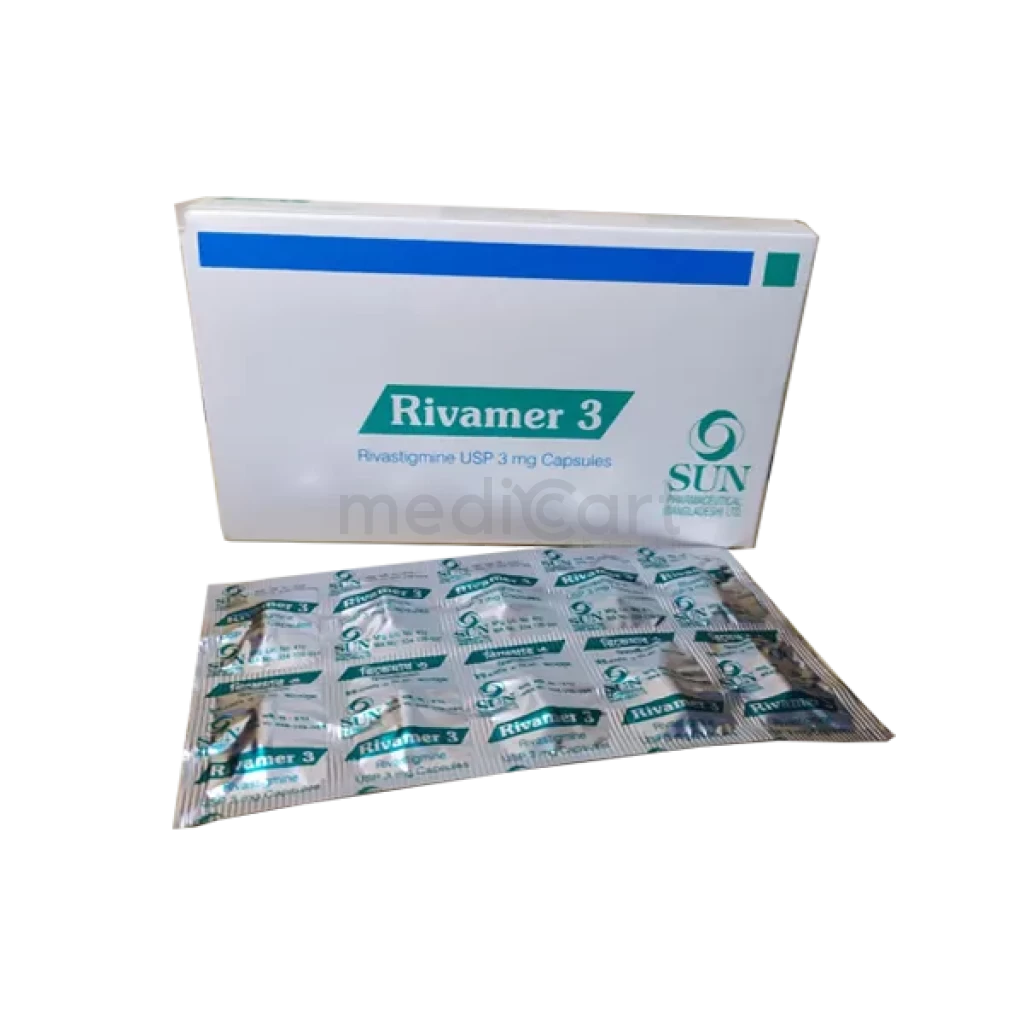

Rivamer - 3 mg
Tablet* Delivery will be done in Dhaka city only.
More Information About - Rivamer - 3 mg
Description
Generic Name
Rivastigmine
Precaution
Patients with sick sinus syndrome or conduction defects, resp diseases. Cholinergic stimulation may increase gastric acid secretion. May exacerbate urinary obstruction and seizures. Pregnancy. Renal impairment, mild to moderate hepatic impairment. Monitor body wt. Asthma or obstructive pulmonary disease. May worsen extrapyramidal symptoms. Lactation. Lactation: Unknown if excreted in milk; not recommended
Indication
Severe dementia in Alzheimer's disease, Parkinson Dementia
Contra Indication
Hypersensitivity to other carbamate derivatives. Severe hepatic impairment.
Dose
N/A
Side Effect
>10% Nausea (PO 47%; patch 21%),Vomiting (PO 31%; patch 6-19%),Dizziness (PO 21%; patch 2-7%),Diarrhea (PO 19%; patch 6-10%),Headache (PO 17%; patch 3-4%),Anorexia (PO 17%; patch 3-9%),Abdominal pain (PO 13%; patch 2-4%) 1-10% Decreased weight (3-8%),Insomnia (PO 9%; patch 1-4%),Anxiety (PO 5%; patch 3%),Asthenia (PO 6%; patch 2-3%),Vertigo (2%),Fatigue (2%) Potentially Fatal: Serious GI reactions such as anorexia, vomiting and weight loss.
Pregnancy Category
Name : Not Classified
Description
FDA has not yet classified the drug into a specified pregnancy category.Mode of Action
Rivastigmine reversibly inhibits hydrolysis of acetylcholine by cholinesterases thus increasing acetylcholine present in the CNS. It is selective for the CNS and is used for the symptomatic treatment of dementia in Alzheimer's disease and idiopathic Parkinson's disease.
Interaction
Not to be used with other cholinomimetic drugs that might interfere with the activity of anticholinergic medications. May exaggerate the effects of succinylcholine-type muscle relaxants during anaesthesia. Tobacco smoking may increase its clearance.
Pregnancy Category Note
Pregnancy There are no adequate data on developmental risks associated with use of drug in pregnant women Animal data In animals, no adverse effects on embryo-fetal development were observed at oral doses 2-4 times maximum recommended human dose (MRHD) Lactation There are no data on presence of drug in human milk, effects on breastfed infant, or on milk production; the drug and its metabolites are excreted in rat milk following oral administration of rivastigmine; levels of rivastigmine plus metabolites in rat milk are approximately 2 times that in maternal plasma; developmental and health benefits of breastfeeding should be considered along with mother’s clinical need for therapy and any potential adverse effects on breastfed infant from drug or underlying maternal condition
Adult Dose
Alzheimer Dementia Oral Indicated for mild-to-moderate dementia of the Alzheimer's type Initial: 1.5 mg PO q12hr Increase by 1.5 mg/dose q2Weeks; not to exceed 6 mg PO q12hr Maintenance: 3-6 mg PO q12hr (higher end may be more beneficial) Transdermal Indicated for mild, moderate, and severe dementia of the Alzheimer's type Initial: Apply 4.6 mg q24hr Dose titration: May increase dose to 9.5 mg q24hr after a minimum 4 weeks if well tolerated; after an additional 4 weeks, may further increase to 13.3 mg patch if needed Mild-to-moderate Alzheimer disease: Effective dosage range is 9.5-13.3 mg/24 hr Moderate-to-severe Alzheimer disease: Effective dose is 13.3 mg/24 hr Replace with new patch q24hr Parkinson Dementia Oral Initial: 1.5 mg PO q12hr Increase by 1.5 mg/dose q4Weeks; not to exceed 6 mg PO q12hr Maintenance: 1.5-6 mg PO q12hr Transdermal Initial: Apply 4.6 mg q24hr May increase dose to 9.5 mg q24hr after a minimum 4 weeks if well tolerated; after an additional 4 weeks, may further increase to 13.3 mg patch if needed Transdermal Mild-to-moderate hepatic impairment: Not to exceed 4.6 mg q24hr
Child Dose
N/A
Renal Dose
Transdermal Renal impairment: No dosage adjustment required
Administration
Should be taken with food.
Disclaimer
The information provided herein are for informational purposes only and not intended to be a substitute for professional medical advice, diagnosis, or treatment. Please note that this information should not be treated as a replacement for physical medical consultation or advice. Great effort has been placed to provide accurate and comprehensive data. However, Medicart along with its authors and editors make no representations or warranties and specifically disclaim all liability for any medical information provided on the site. The absence of any information and/or warning to any drug shall not be considered and assumed as an implied assurance of the Company.







